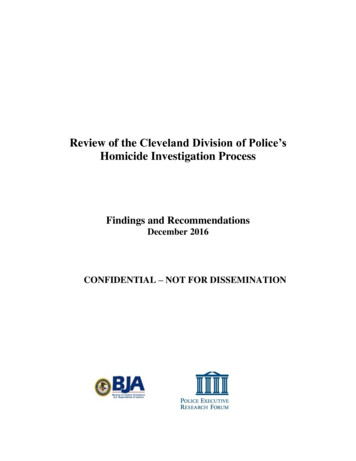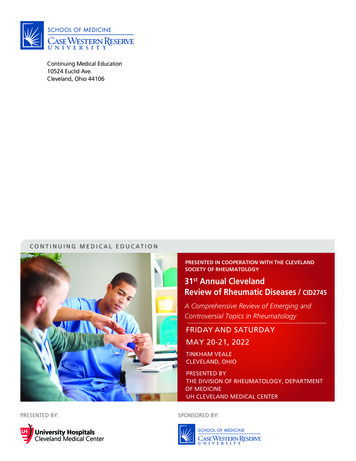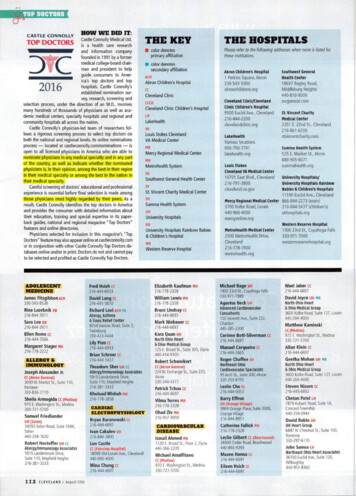
Transcription
Review of the Cleveland Division of Police’sHomicide Investigation ProcessFindings and RecommendationsDecember 2016CONFIDENTIAL – NOT FOR DISSEMINATION
December 2016Confidential – Not for DisseminationExecutive SummaryWhen a human life is lost due to violence, the devastating effects are felt throughout the entirecommunity. This is why one of the most important functions of local police agencies is tothoroughly investigate homicide cases and bring justice to victims and their families.Effective homicide investigations are also critical for protecting the overall safety and well-beingof the community. Homicide detectives can play a key role in preventing future deaths byidentifying and apprehending perpetrators and incapacitating offenders.1 Additionally, byutilizing tools such as crime analysis, police agencies can understand ongoing crime patterns andtrends regarding violence related to gangs and drugs. This can help police anticipate whenretaliation killings are likely and intervene to prevent one homicide from sparking a series ofkillings.Finally, by ensuring that homicide detectives are thoroughly trained and provided with theresources they need, police agencies can also help prevent the possibility of wrongful convictionscaused by false eyewitness identification or other evidentiary problems.Project BackgroundIn 2014, the Police Executive Research Forum (PERF) was selected by the U.S. JusticeDepartment’s Bureau of Justice Assistance (BJA) to implement and manage the HomicideInvestigations Enhancement Training & Technical Assistance Project. As part of this project,PERF is conducting comprehensive assessments of the homicide investigation policies andpractices within four police departments across the country, and is assisting each site withimplementing strategies to strengthen its homicide investigation function. The project sites werechosen based on criteria that included: a recent rise in homicide rates, homicide clearance ratesthat are decreasing and/or below the national average, and a commitment of police departmentleaders to improving homicide investigation procedures.In the City of Cleveland, Ohio, the number of homicides has steadily risen since 2013. In 2015the city experienced 128 homicides, compared to 101 homicides in 2013. Furthermore, startingin 2013 the Cleveland Division of Police (CDP) also experienced a significant drop in itshomicide clearance rates. In 2012 the department cleared 71 percent of homicide cases; sincethat time, the CDP Homicide Unit’s clearance rate has hovered in the 51-56 percent range, and in2015 the clearance rate was 56 percent. This matches the national clearance rate for cities withCleveland’s population size, which was also 56 percent in 2015.2 The CDP agreed to participatein this project with the goal of strengthening its homicide investigation process and bringing itsclearance rate back to the higher levels of several years ago.1Carter, David L. (2013), Homicide Process Mapping: Best Practices for Increasing Homicide Clearances,Washington, DC: Bureau of Justice Assistance,http://www.iir.com/Documents/Homicide Process Mapping September email.pdf.2FBI, “2015 Crime in the United States.” -the-u.s.2015/tables/table-251
December 2016Confidential – Not for DisseminationPERF began its review of the CDP’s homicide investigation policies and practices in April 2016.This review was conducted by an assessment team comprised of law enforcement practitionersand researchers with expertise and experience in homicide investigations. The review included:onsite interviews with more than 50 CDP personnel from across the department; interviews withpersonnel from the Cuyahoga County Medical Examiner’s Office (CCME), the CuyahogaCounty Prosecutor’s Office (CCPO), and the Cleveland Police Patrolmen’s Association (CPPA);a review of files from 114 homicide cases that occurred between January and October 2015; anda review of the CDP’s written policies, homicide logs and data, organizational charts, and samplecrime reports.Summary of Findings and RecommendationsThis report summarizes the key findings and recommendations that emerged from PERF’sreview. At the outset, two important points should be noted.First, though the CDP is facing extremely significant challenges with respect to staffing,equipment, technology, and other resources, PERF found that Homicide Unit personnel – alongwith CDP leaders and other personnel from throughout the department -- demonstrated a strongcommitment towards solving homicides and improving the investigation process. In manyways, they are doing the best job that can be expected given the limited resources available.The recommendations provided in this report aim to ensure that these committed individualshave the support, guidance, and tools they need to better serve the City of Cleveland.Second, many of the challenges faced by the CDP are not unique. Although therecommendations in this report are tailored to the CDP, many recommendations could apply topolice agencies throughout the country. Like the CDP, many other police agencies are strugglingwith declining or stagnant homicide clearance rates, and many of these agencies share commonproblems – understaffed investigative units, a general lack of funding, gaps in training andsupervision, etc. – that can have an impact on how cases are investigated.Following are the key findings from PERF’s review and recommendations for strengthening theCDP’s homicide investigation processes and improving homicide clearance rates. Theserecommendations are based on existing research and best practices for conducting homicideinvestigations.1) Written Policies and Procedures: The CDP’s existing written policies and proceduresfail to provide meaningful investigative guidance or accountability. Recommendation – Update Written Policies: The CDP should update the writtenpolicies and procedures that govern homicide investigations, including revising theexisting Homicide Unit Manual. Policy revision should involve a department-widefocus on examining and updating the written policies for all CDP units involved inhomicide investigations. Recommendation – Revise Policy Content: Policies should include detailed,substantive direction on topics such as: detective duties and responsibilities;detective selection and supervision; training; performance evaluations and other2
December 2016Confidential – Not for Disseminationaccountability mechanisms; and the steps that must be taken during each stage of theinvestigative process. Recommendation – Disseminate Policies to Detectives: All new HomicideUnit detectives should receive a copy of the revised Homicide Unit Manual. Theyshould be trained on and held accountable for following the directives contained inthe manual. Recommendation – Incorporate Best Practices into Policies: Revised policiesshould incorporate the recommendations in this report and the current research onbest practices for homicide investigations.2) Staffing and Caseload Management: Detectives in the Homicide Unit are currentlycarrying very large caseloads due to unit understaffing and its current shift structure. In2015, each CDP Homicide Unit detective worked an estimated average of 10 new homicidecases during the year, which is twice the number that is recommended according to researchon homicide investigation best practices.3 This is a key problem that the CDP mustimmediately address. Revisions to policies, training, and other areas discussed in this reportwill not have the desired impact unless the CDP commits to providing the Homicide Unitwith necessary staffing resources. Recommendation – Increase Homicide Unit Staffing: The Homicide Unitideally should be staffed so that each detective is the lead on an average of four tosix new homicide cases per year. Recommendation – Revise On-Call System: PERF’s review of CDP homicidedata found that more homicides occur during the overnight shift (12am-8am) than atany other time. However, the Homicide Unit does not have a full-time overnightshift, and its current on-call system contributes to detectives’ large caseloads andmakes it difficult for detectives to respond to homicide scenes within therecommended 30-minute period. Research shows there is a relationship betweencase clearance and whether detectives arrive at the scene during this 30-minutewindow; 4 however, PERF’s case review found documentation of detectives arrivingat the crime scene within 30 minutes in only around 15 percent of the casesexamined. The Homicide Unit should consider implementing a full-time overnightshift or, at a minimum, rotating the on-call detectives more frequently (the currenton-call rotation is one month). Recommendation – Review Homicide Data: The Homicide Unit should reviewdata to determine the times of day and days of the week when homicides are mostlikely to occur in Cleveland. This will help the unit assess the times when moredetectives are needed to cover incoming cases. Recommendation – Reduce Detective Caseloads: When possible, the CDPshould seek to maximize the amount of time that Homicide Unit detectives spendinvestigating homicide cases by limiting the time they spend performing other3Carter, David L. (2013), Homicide Process Mapping: Best Practices for Increasing Homicide Clearances,Washington, DC: Bureau of Justice Assistance,http://www.iir.com/Documents/Homicide Process Mapping September email.pdf.4Wellford, Charles and James Cronin, Clearing Up Homicide Clearance Rates, National Institute of Justice Journal(April 2000), https://www.ncjrs.gov/pdffiles1/jr000243b.pdf. See also the full report for a more comprehensive lookat this study: An Analysis of Variables Affecting the Clearance of Homicides: A Multistate Study (October 1999),http://www.jrsa.org/pubs/reports/homicides report.pdf.3
December 2016Confidential – Not for Disseminationduties, such as investigating non-homicide cases, performing administrative work,and serving on departmental details. Recommendation – Provide Updated Equipment: The CDP should considerequipping Homicide Unit detectives with tablets, smartphones, or other devices thatwould enable them to perform tasks while in the field. This would help themperform their jobs more efficiently and reduce the amount of time spent going fromthe field to the office.3) Detective Selection and Training: The CDP’s current detective selection process is notbased on a set of standard, objective criteria that will adequately ensure that Homicide Unitdetectives are chosen based on their ability to investigate cases. This is especiallyproblematic given a lack of consistent, formal, and in-depth investigative training providedto detectives in CDP investigative units, including the Homicide Unit. Recommendation – Revise Selection Process: CDP leaders should work with theCPPA to revise the bargaining agreement that governs detective selection.Detectives should be selected into the Homicide unit pursuant to a rigorous, formalprocess, using a set of established qualification criteria that are consistently appliedto all candidates. Recommendation – Require Basic Investigations Training: New detectives inall investigative units should receive mandatory training on basic investigation skillsand techniques, including case management and documentation, crime scenemanagement, report writing, interview and interrogation skills, basic forensics,evidence collection (including digital evidence), managing witnesses, the use oftechnology, legal requirements, and departmental policies and procedures. Recommendation – Require Advanced Training for Homicide Detectives:Detectives in the Homicide Unit should receive training – both upon entering theunit and throughout their tenure in their unit – on advanced investigative techniquesspecific to conducting death investigations. In addition to the investigative skillstaught to all new detectives, Homicide Unit detectives should receive training onconducting death investigations, constitutional law, advanced forensics and evidencecollection, crime analysis, best practices for homicide investigations, and how toinvestigate specific types of cases handled by Homicide detectives, such as officerinvolved shootings and child fatalities. Recommendation – Strengthen On-the-Job Training: The CDP shouldstrengthen its on-the-job (OJT) training to ensure that new Homicide Unit detectivesreceive appropriate field training and mentoring. This includes developing an OJTguidebook and setting benchmarks that new Homicide Unit detectives must meetbefore they are assigned full time to the unit.4) Supervision, Accountability, and Oversight: PERF found that detectives in the CDP’sHomicide Unit are talented and committed to their work. However, the CDP should putmechanisms in place to ensure that detectives have the guidance and oversight they need tothoroughly and effectively investigate homicide cases. Recommendation – Strengthen Documentation and Data Collection: TheCDP should take steps to ensure that cases are properly documented. This includesincluding directions on proper case documentation and reporting in the revised4
December 2016 Confidential – Not for DisseminationHomicide Unit Manual, as well as strengthening the department’s electronic recordsmanagement system so that it can be fully leveraged by Homicide Unit detectives.The Homicide Unit should also collect and maintain consistent statistical dataregarding measures such as detective clearance rates and caseloads.Recommendation – Establish Investigative Plan and Checklist: At the outsetof each case, Homicide Unit supervisors should work with detectives to establish adetailed investigative plan and formal case checklist. Sample investigative plans andchecklists should be included in the revised Homicide Unit Manual and should bepart of the official case file.Recommendation – Conduct Supervisory Case Reviews: Supervisors shouldconduct mandatory, regular case reviews for the purpose of identifying potential newleads, addressing any gaps in the detective’s investigative process, and updating theinvestigative plan. The review process should be outlined in the Homicide UnitManual and should include reviews of the investigative plan and checklist, as well asthe detectives’ reports and case file documentation.Recommendation – Strengthen Evaluation Process: The Homicide UnitManual should outline a formal process for evaluating Homicide Unit detectives.Evaluations should be designed to measure whether the detective is conductingthorough investigations, performing all necessary case follow up, and properlydocumenting all investigative tasks and findings. Evaluations should be conductedevery six months and should include a review of each detective’s case files,clearance rates, supervisor assessments, and detective self-assessments. The CDPshould have a formal plan in place for providing additional training and assistance tounderperforming detectives.Recommendation – Establish a Cold Case Unit: The CDP should exploreestablishing a Cold Case Unit whose mission is to clear unsolved homicide cases andprovide a reliable quality assurance check on homicide investigations.5) Internal and External Coordination: Successful homicide investigations rely oncollaboration among various units within the CDP, as well as with external stakeholderssuch as prosecutors and crime lab technicians from the Cuyahoga County MedicalExaminer’s Office. PERF found that more coordination and communication between theseunits are needed. Recommendation – Emphasize the Team Approach: CDP leaders shouldprioritize improving cross-agency communication and collaboration and shouldemphasize the importance of taking a team approach to preventing and solvingcrimes. This message should be reinforced in written policies and training. The CDPshould consider assembling a homicide investigations team to provide input onpolicy development, share ideas for strengthening the investigation process, andimprove cross-agency information Recommendation – Strengthen Information-Sharing Processes: The CDPshould coordinate regular training briefings, during which members of the variousunits could brief one another about their policies, protocols, capabilities, andmissions. This would help units better understand how their missions, goals, andfunctions intersect.5
December 2016Confidential – Not for Dissemination Recommendation – Provide Adequate Resources to CDP Units: The CDPshould take steps to ensure that all units involved in homicide investigations have thestaffing, training, equipment, and technology they need to successfully completetheir missions. Recommendation – Prioritize Response to Non-Fatal Shootings: The CDPshould make it a priority to immediately respond to and investigate all shootings,including non-fatal shootings, that occur in the City of Cleveland. The departmentshould implement policies that require detectives from the District Detective Units torespond to the scene of a non-fatal shooting, and should take steps to improveongoing collaboration between the Homicide Unit and DDU detectives. Recommendation – Expand Crime Analysis: The CDP should invest in thestaffing, tools, and technology needed to expand its crime analysis capabilities.Research has shown that crime analysis can play a critical role in effective homicideinvestigations.5 Putting the mechanisms in place to better understand connectionsbetween crimes, suspects, victims, witnesses, locations, etc. could help greatlystrengthen the CDP’s investigative process. Recommendation – Strengthen Coordination with External Agencies: CDPleaders should work with officials from the Cuyahoga County Prosecutor’s Officeand the Cuyahoga County Medical Examiner’s Office to establish stronginformation-sharing protocols and ensure that their policies and goals are aligned.Moving ForwardThe CDP must continue to demonstrate that preventing and solving homicides is a top priorityfor the department. Participating in this project is a good first step towards this goal, and theCDP must now build upon these efforts by ensuring that personnel have the guidance andsupport they need to conduct thorough homicide investigations, improve clearance rates, andbetter protect and serve the City of Cleveland.PERF, with support from BJA, can provide ongoing technical assistance to help the CDPimplement these reforms. In addition to providing the CDP with guidance on best practices,PERF will work with BJA to establish a consortium of experts comprised of practitioners,trainers, researchers, and others experienced in homicide investigations, to provide training andtechnical assistance. PERF will also help connect CDP leaders with other police agencies thatcan provide peer-to-peer assistance with training, policy development, and the implementation ofeffective homicide investigation strategies.5Carter, David L. (2013), Homicide Process Mapping: Best Practices for Increasing Homicide Clearances,Washington, DC: Bureau of Justice Assistance,http://www.iir.com/Documents/Homicide Process Mapping September email.pdf.6
Review of the Cleveland Division of Police’sHomicide Investigation ProcessFindings and RecommendationsDecember 2016CONFIDENTIAL – NOT FOR DISSEMINATION
December 2016Confidential – Not for DisseminationTable of ContentsIntroduction . 3Summary of Findings and Recommendations . 3Methodology. 5Homicide Unit Policies and Procedures . 6Homicide Unit Manual Contents. 6Homicide Unit Manual Usage . 7Recommendations: Homicide Unit Policies and Procedures . 7Detective Selection Process . 10The CDP Homicide Unit Detective Selection Process . 11The Impact of the Current Detective Selection Process . 12Recommendations: Detective Selection Process . 13Investigations Training . 15Formal Investigations Training . 15On-the-Job Training . 16Recommendations: Investigations Training . 17Homicide Unit Staffing and Caseload Management . 20Homicide Unit Staffing and Responsibilities . 20Homicide Unit Shifts and Case Rotation . 22Homicide Unit Caseloads . 23Recommendations: Homicide Unit Staffing and Caseload Management. 27Supervision, Accountability, and Oversight. 31Detective Supervision . 32Case Documentation and Review . 33Performance Evaluation and Accountability Mechanisms . 35Recommendations: Supervision, Accountability, and Oversight . 36Internal and External Coordination . 41Overall Coordination and Communication . 42District Detective Units . 45The Gang Impact Unit . 49Video Forensics Unit . 531
December 2016Confidential – Not for DisseminationCrime Analysis Unit . 55Patrol Units . 59Internal Forensics Units . 61External Crime Lab – the Cuyahoga County Medical Examiner’s Office. 66The Cuyahoga County Prosecutor’s Office . 69Working with the Community. 71Homicide Unit Equipment and Technology. 73Recommendations: Homicide Unit Equipment and Technology . 73Conclusion. 75Appendix A: Findings from the PERF Case Review . 77Appendix B: Cleveland Division of Police Homicide Assessment Project Team. 81Appendix C: References and Resources . 822
December 2016Confidential – Not for DisseminationIntroductionIn 2014, the Police Executive Research Forum (PERF) was selected by the U.S. JusticeDepartment’s Bureau of Justice Assistance (BJA) to implement and manage the HomicideInvestigations Enhancement Training & Technical Assistance Project. As part of this project,PERF is conducting comprehensive assessments of the homicide investigation processes in fourpolice departments across the country, recommending individualized strategies to improvehomicide clearance rates, and offering ongoing technical assistance to help each site implementthe recommendations.This report summarizes PERF’s review of the Cleveland, Ohio Division of Police (CDP) andprovides recommendations for addressing gaps in policies and procedures in order to improvethe CDP’s homicide clearance rates.Though the CDP is facing significant challenges with respect to staffing, equipment,technology, and other resources, PERF found that Homicide Unit personnel – along withCDP leaders and other personnel from throughout the department -- demonstrated astrong commitment to solving homicides and improving the investigation process. Therecommendations in this report aim to ensure that these committed individuals have the support,guidance, and tools they need to better serve the City of Cleveland.Summary of Findings and RecommendationsPERF’s recommendations are based on research and best practices for homicide investigations,and focus on the following key areas of concern that PERF identified during its review: Homicide Unit Policies and Procedures: The CDP’s existing written policies andprocedures, particularly the Homicide Unit Manual, fail to provide meaningfulinvestigative guidance or accountability. It contains information that is outdated, unclear,and irrelevant to homicide investigations, and most of the Homicide Unit detectives andsupervisors were unaware of the manual’s existence or were unfamiliar with its contents.The Homicide Unit Manual should be revised to provide clear policy directives, anddetectives should be trained on it and held accountable for using it. Detective Selection Process: The CDP’s current detective selection process is notbased on a set of standard criteria that will adequately ensure that Homicide Unitdetectives are chosen based on their ability to investigate cases. The CDP should revisethe detective selection process so that it is based on objective criteria for assessinginvestigative ability. This process should be outlined in the Homicide Unit Manual andconsistently applied for all candidates. Investigations Training: Detectives in the CDP’s investigative units, including theHomicide Unit, do not receive consistent, formal, and comprehensive investigationstraining. This training gap exists for both new and veteran detectives. All CDP3
December 2016Confidential – Not for Disseminationdetectives should receive formal investigative training, and Homicide Unit detectivesshould receive specialized training related to investigating homicide cases. Homicide Unit Staffing and Caseload Management: Detectives in the HomicideUnit are currently carrying very large caseloads due to unit understaffing and the currentshift structure. This is a key problem that the CDP must address immediately. Revisionsto policies, training, and other areas discussed in this report will not have the desiredimpact unless the CDP commits to providing the Homicide Unit with necessary staffingresources. It is important for the CDP to implement strategies to relieve the currentcaseload burden on Homicide detectives. Supervision, Accountability, and Oversight: Detectives in the CDP’s Homicide Unitare talented and committed to their work. However, the Homicide Unit lacksmechanisms for ensuring that detectives are properly supervised and evaluated, and thereis no formal case planning or review system to ensure that cases are being investigatedthoroughly and effectively. Implementing these accountability mechanisms is critical forstrengthening the Homicide Unit. Internal and External Coordination: There is a significant lack of coordination andcommunication among the various CDP units. The department is highly fragmented; andunits largely act independently of one another, even though their missions and functionsoften overlap. The CDP must take steps to improve coordination throughout thedepartment and ensure that units have the staffing, training, and resources they need tocomplete their missions. Homicide Unit Equipment and Technology: The CDP’s Homicide Unit is lackingmany of the tools and technologies necessary to perform basic investigative functions.The CDP must review the resource needs of the Homicide Unit and develop a plan foraddressing these needs, both presently and as its needs change moving forward.PERF recognizes that many o
implementing strategies to strengthen its homicide investigation function. The project sites were chosen based on criteria that included: a recent rise in homicide rates, homicide clearance rates that are decreasing and/or below the national average, and a commitment of police department leaders to improving homicide investigation procedures.











